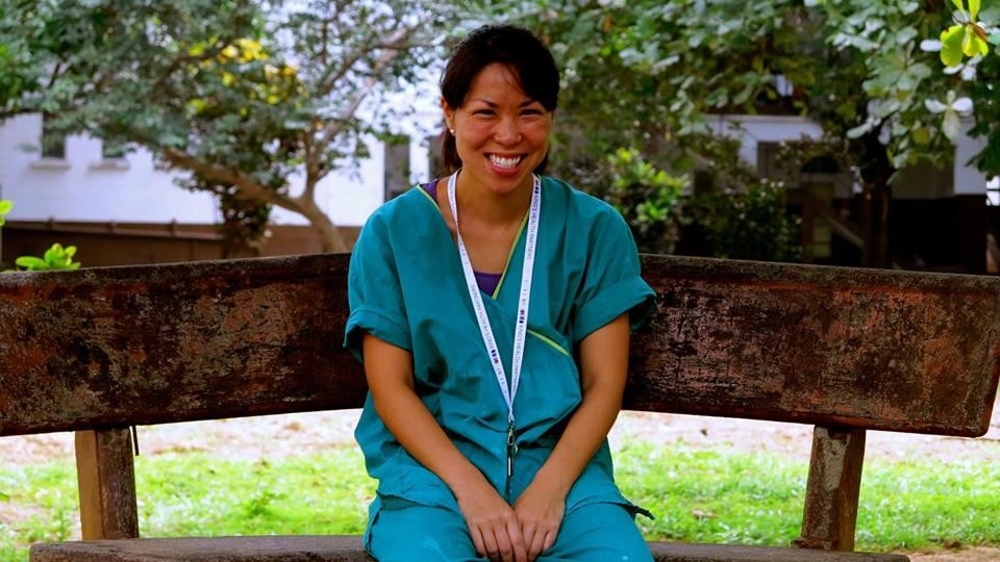Alumni spotlight: Jeri Sumitani, MMSc, PA-C
Battling Ebola: A View from the Front Line |

The following personal blog excerpts were written by Jeri Sumitani in 2014 and were previously published in WebMD Health News.
When the Ebola outbreak reached a critical point in the summer of 2014, I asked to volunteer in West Africa.
I ended up working at Connaught Hospital, the sole facility in Freetown to keep its doors open to Ebola and non-Ebola patients. Here are some of my experiences.
Day 1 | Although any job begins with an orientation process, this one carried with it an acute sense of gravity. Not paying attention could literally mean life or death. Nevertheless, I felt surprisingly calm and safe in my Personal Protection Equipment (PPE).
Day 3 | We lost a 5-year-old child today. There was a moment when the thought of CPR crossed my mind, but logic quickly took over. The strangest thing for a Western-trained health care professional is to stand by and do nothing while a patient dies in front of your eyes. At the same time, it allowed us to spend the last few minutes of the little girl’s life with her and truly be present throughout her death.
Day 6 | One of my tasks today was to select patients from the screening tent to admit to the isolation unit. This is the ultimate triage job—you have to choose which patients get to come inside and lie in a bed, receive food, water, and possibly some symptom relief. The others wait in the “tent of horror” until someone is discharged, transferred to a treatment center, or dies.
Day 7 | Triaging suspected Ebola is an imperfect science. The goal is to identify those who are clinically unstable or who are experiencing profuse vomiting and/or diarrhea and may put others at risk. We try to prioritize children since many of the holding units in the area do not have pediatricians, so children often receive suboptimal care. The dead are quickly removed from the tent into the isolation unit morgue, as corpses are particularly infectious. In many cases, we have no choice but to send the Ebola-positive patients on a five-hour journey to Kenema where they have more Ebola treatment units.
Day 18 | A young girl about 16 years old came up to me this morning asking about her mother who had been brought in two days ago. I had to tell her, “Your mother is going to Kerry Town now in that ambulance,.” As soon as her mother was carried out of the isolation unit, the girl started crying. But then she stopped. With eyes fixed on her mother, she started singing. It was more of a chant than a song—a haunting hymn that hypnotized me.
Day 25 | I wake to the sound of ambulance sirens. I know that this signifies more cases of Ebola or related deaths. Sierra Leone has never had a functional, 911-type centralized emergency response service. A command center was established as a result of the Ebola outbreak. Sierra Leoneans are encouraged to call “117” if they experience any signs or symptoms of Ebola. An ambulance and trained health care workers respond to the caller with the goal of rapid isolation and transfer to a holding unit. It is true that there remains a mountain of work to do to control this epidemic, and with it comes a feeling of helplessness. But amid all the death and suffering, I witnessed collaboration between organizations, local and international, and good work being done by many hard-working people. Whatever your acronym—WHO, CDC, UN, MSF—in Sierra Leone right now, everybody is fighting the same enemy. Although it is not perfect by any means, it is what international aid was intended to be.
Day 45 | It’s New Year’s Eve. I sit at Sierra Leone’s airport waiting for my plane. Looking back on my six weeks here, I struggle to find words to describe my experience.
Day 21 Post Re-Entry | I learned the power of human connection. Ebola is a disease that steals every shred of humanity and dignity from those affected. It even steals physical touch. But then I realized human connection encompasses much more than physical contact. Patients shed tears of relief when I acknowledged their pain. Just making eye contact with patients too weak to talk gave us a semblance of connection. And when patients died in the isolation unit, we would talk to the family members for as long as they needed and often cry with them. I am not saying any of this was enough. But these little moments of human connection restored some humanity and dignity in a situation that is so devoid of both.

